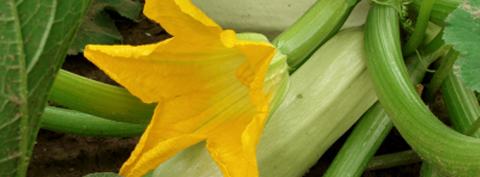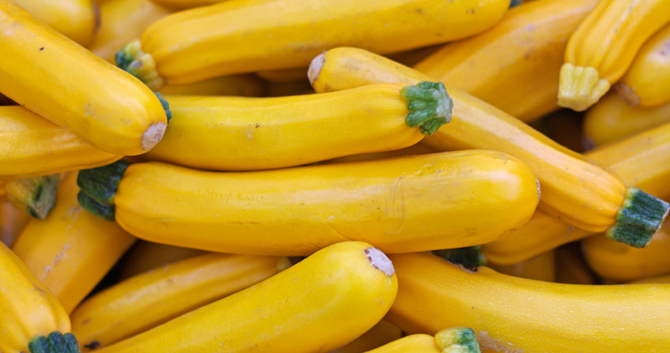No garden would be complete without some type of squash – and from delicate green zucchini to prize winning pumpkins, there’s a squash for everyone!
 Squash is extremely versatile - the blossoms, seeds, and flesh are all edible.
Squash is extremely versatile - the blossoms, seeds, and flesh are all edible.
All squash are native to the Western Hemisphere, where they originally grew wild from South America to Mexico. These ancestors of today’s squash were bitter and unpalatable with tough rinds and little flesh. First cultivated in Mexico and Central America for their edible seeds, squash varieties were cross bred over time to create the sweet-fleshed varieties we know today.
Christopher Columbus brought squash back to Europe from the New World, where it gained popularity in areas with favorable growing conditions, primarily in Southern Europe. Like many other Native American foods, squash were then spread throughout the world by Portuguese and Spanish explorers. Italy is credited for being the first to try the immature young squash known as zucchini or courgette.
Types of Squash:
All squashes are in the Cucurbitaceae family and are closely related to cucumbers and melons. They come in a wide variety of colors, patterns, shapes, and sizes — from white, light green or yellow to dark green and orange, there are solid, speckled, and striped varieties in round, oblong, saucer, and hooked shapes.
 Winter squash are harvested fully mature while summer squash are harvested early.
Winter squash are harvested fully mature while summer squash are harvested early.
In general, there are two types of squash – summer and winter. Summer squash are harvested young, before the rind hardens and the fruit matures. As a result, they have thin skins and are high in moisture. Winter squash stay on the vine longer and are fully mature when harvested. They have thick outer rinds and sweet, rich inner flesh.
Summer Squashes begin to produce in the warmer weather, about 50 days after planting, and are continually harvested until the first frost. There are many types of summer squash with distinctly different shapes, flavors, sizes, and colors. As a rule of thumb, summer squash is best when still small and sweet.
Zucchini: This deep green summer squash rarely disappoints! With a light, sweet flavor and reputation for being very prolific, zucchini have become a summer squash favorite.
 Summer squash will produce all season. Winter squash are harvested once.
Summer squash will produce all season. Winter squash are harvested once.
Straight neck: This early summer squash has tender, cream-colored fruit with a buttery, more complex flavor than zucchini. Good for slicing, straight neck squash is most flavorful when picked before full maturity. They become more dry and starchy as they age and should be picked when they are about four to seven inches long.
Crook neck: This squash is similar to straight neck varieties in terms of color, taste, and texture but as the name implies it has a crooked neck, making it better for stuffing than slicing.
Patty pan: Also known as scallop squash, this summer squash is prized by chefs for its sweet, rich, nutty flavor and unique decorative shape. Usually yellow or green in color and shaped like saucers, patty pan squash is best when harvested at 3-4 inches in diameter.
Winter squash is a true harbinger of fall. Harvested when the cool weather sets in at the end of summer, they transform gardens into treasure troves filled with round, elongated, scalloped, or pear-shaped squash in autumn hues ranging from golden-yellow to brilliant orange. With hollow interiors and firm, hard rinds with a thick lining of sweet golden flesh, winter squashes are ideal for stuffing and roasting.
Acorn Squash: This small winter squash has a mildly sweet flavor with peppery undertones. Dark green, orange, or white and deeply ribbed outside, richly golden and tender inside, they’re delicious baked, mashed, steamed, or sautéed. Weighing one to three pounds each, acorn squash is a perfect side dish for one to four people.
Butternut Squash: With a sweet nutty flavor similar to butterscotch and sweet potatoes, butternut squash warms the heart on cold winter days. Long, bell-shaped and beige on the outside, butternut squash is deep orange on the inside. As a general rule, the darker the color, the riper and sweeter the squash.
Hubbard: This large blue/grey squash has a delicate flavor that’s less sweet than other winter squashes but still delicious. They keep well, continue to sweeten the longer they’re stored, and can be used in recipes as a substitute for pumpkin.
Spaghetti squash: Golden yellow with a sweet, buttery flavor, this squash shreds into strands resembling pasta when cooked. The larger the squash, the thicker the strands.
 Winter squash is both delicious and decorative.
Winter squash is both delicious and decorative.
Turban squash: This green winter squash has orange-yellow flesh that tastes like hazelnuts. As decorative as they are delicious, these white, green, or orange squashes have a distinctive turban shape, as the name implies.
Kabocha squash: This Japanese squash has very sweet orange flesh that tastes like a blend of pumpkin and sweet potatoes. Usually baked or steamed, they can also be used in recipes that call for pumpkin.
Pumpkin: Pumpkins are the epitome of fall. Sweet, dense, sugar or pie pumpkins are prized in the kitchen, used in pies, breads and soups. Larger, hollow-centered types are iconic for decorative jack-o-lanterns that adorn front lawns to the delight of trick-or-treaters. And no state fair would be complete without a giant pumpkin contest!
 Summer Squash can be planted anytime after the danger of frost has passed.
Summer Squash can be planted anytime after the danger of frost has passed.
Getting Started:
Squash is an extremely low maintenance crop that only needs adequate sun, water, and space to grow and thrive. Select a site that gets at least 6 hours of sun per day and be sure the hose will reach.
Most squash prefer loose, fertile soil and will struggle in heavy clay. Prepare the soil by mixing in three inches of compost and organic fertilizer. If your soil is clay based, choose a location on high ground where water will not pool after a heavy rain. Amend with an extra two inches of peat moss or compost, and till well into the native clay to create a deep, well-drained planting bed.
Care Tips:
Summer and winter squashes have very similar care requirements. They’re easy to grow and extremely productive with a few simple care tips.
Planting:
Plant any time after the danger of frost has passed, from early spring until mid-summer. Squash are usually planted in hills of 2 plants, spaced 4 to 12 feet apart depending on the variety. This gives plants plenty of room to grow and spread.
Watering:
Water plants regularly to keep soil consistently moist and ensure best quality fruit. Check the soil to see if it is moist an inch or two below the surface, and water deeply as needed. A soaker hose or drip irrigation is ideal, to keep foliage dry and healthy.
Mulching:
To help ensure plants stay moist and well-fed, apply a 2 to 3 inch layer of composted mulch after planting. The mulch should be kept a few inches away from the seedling’s stems, and will provide a weed-free space where the vines can spread.
Fertilizing:
All squashes are heavy feeders, using the nutrients to grow large and strong. Use a high nitrogen fertilizer early, to get them off to a good start. Give them lots of potassium when they flower and start to grow fruit. Choose a product formulated for fruiting vegetables and follow package directions.
 Squash blossoms are a delicacy to enjoy early in the season
Squash blossoms are a delicacy to enjoy early in the season
Harvesting:
Summer squash are best when harvested young – when seeds are small and skins tender. They develop quickly after the fruit forms so keep your eye on them and harvest when they reach four to seven inches in diameter. Use a sharp knife to cut the fruit at its stem, to avoid damaging the vine.
Winter squash needs time to fully mature before harvesting. Wait until the stem dries and the rind takes its mature color and hardens. If unsure, wait until right before the first frost before harvesting.
Companion Plants:
Native Americans considered squash one of the “three sisters,” along with corn and beans. They planted these three crops together to enhance the development of each, with the corn providing shelter and support for the beans, beans adding nitrogen to the soil, and squash acting as a living mulch to suppress weeds and hold in moisture. Other great companion plants for squash include:
- Fragrant herbs and flowers like marigolds, petunias, nasturtium, dill, mint, and oregano help ward off pests
- Borage improves growth and flavor, and deters worms
- Onions and radishes also deter pests
- Sunflowers planted near squash attract pollinators and provide a wind shield.
Conversely, squashes should not be planted near potatoes as they will reduce the spud’s blight resistance.
Troubleshooting:
Squashes are fairly problem free, but can struggle when Mother Nature does not cooperate or when growing conditions are less than ideal.
If flowers shrivel without turning into fruit, especially early in the season, they lack pollination and your bees need a motivational talk. If that doesn’t work, you can hand pollinate by using a small brush to rub the pollen from the male flower onto the female. Look for a green bulge at the base of the flower—these are the female blooms.
To help prevent wilting right after transplanting, shade your squash with an upside down flower pot for a couple of days.








